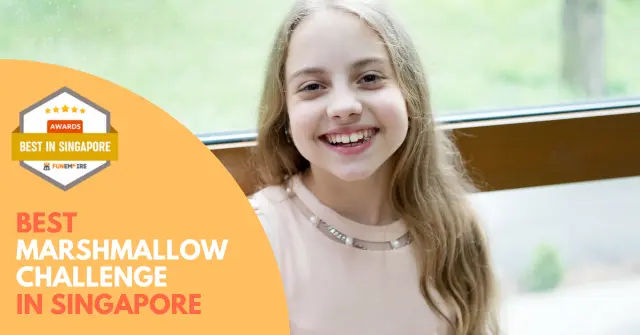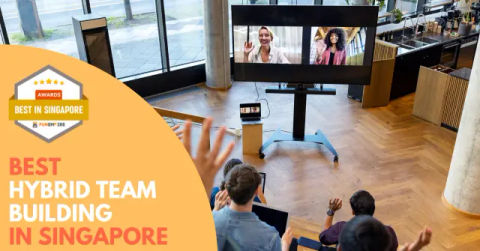Marshmallow Challenge Singapore

The Marshmallow Challenge presents a unique and engaging way for teams to enhance their collaboration skills.
The best marshmallow challenge ideas in Singapore include The Singapore Skyline Challenge, The Hawker Centre Challenge, and The Garden City Challenge
When selecting an idea for a marshmallow challenge, take into account factors like time limitations, the size of the group, and their interests.
Originating as a simple yet insightful team-building game, it pushes groups to exercise innovative thinking, teamwork, and problem-solving under time constraints.
In this article, we’ll explore five innovative Marshmallow Challenge ideas specifically tailored to enhance team collaboration within Singaporean organizations.
Quick Summary
- Best marshmallow challenge ideas in Singapore include The Singapore Skyline Challenge, The Hawker Centre Challenge, and The Garden City Challenge
- When deciding for a marshmallow challenge idea, consider factors such as time constraints, group size and interests
- Marshmallow challenge ideas can be tailored to promote specific team skills like creativity, communication or leadership.
Understanding the Marshmallow Challenge
The Marshmallow Challenge isn’t just about building structures—it’s about nurturing essential skills like collaboration, creativity, and problem-solving. Teams must work together, leveraging each member’s strengths, to achieve a common goal.
This challenge serves as a microcosm of real-world projects, where effective communication and teamwork are paramount for success. By participating in the Marshmallow Challenge, teams develop a deeper understanding of collaboration dynamics and learn valuable lessons that can be applied in the workplace.
Importance of Team Collaboration in Singapore
In Singapore’s fast-paced business environment, teamwork plays a crucial role in driving innovation and achieving organizational goals. Companies across various industries recognize the significance of fostering a collaborative culture to stay ahead.
For Singaporean businesses, harnessing the collective intelligence of diverse teams is key to navigating challenges and seizing opportunities in a rapidly evolving market. The Marshmallow Challenge presents an engaging way to cultivate teamwork skills and foster a sense of camaraderie among team members.
Best Marshmallow Challenges In Singapore
1. The Singapore Skyline Challenge
Teams will recreate iconic buildings or landmarks in Singapore using Marshmallow Challenge materials. This challenge encourages creativity, attention to detail, and effective communication among team members.
Mechanics:
- Provide teams with images or models of famous Singaporean landmarks.
- Allocate a specific time frame for planning and construction.
- Encourage teams to incorporate unique features of each structure into their designs.
Pros
- Promotes teamwork and creativity.
- Enhances appreciation for Singaporean landmarks.
- Provides an engaging team-building experience.
Cons
- Requires careful planning and coordination.
- Limited by available materials.
- Complexity may vary based on team skill levels.
2. The Hawker Centre Challenge
Teams will design and build miniature hawker center stalls using spaghetti, tape, string, and a marshmallow. This challenge promotes teamwork, innovation, and cultural appreciation by allowing participants to recreate the vibrant atmosphere of Singaporean hawker culture.
Mechanics:
- Assign each team a specific type of hawker cuisine to represent in their stall.
- Set criteria for judging, such as authenticity, creativity, and presentation.
- Allow teams to pitch their stall concepts and explain the significance of their chosen cuisine.
Pros
- Celebrates Singaporean culture and teamwork.
- Encourages creativity and innovation.
- Provides a hands-on learning experience.
Cons
- Cleanup may be messy.
- Requires familiarity with hawker culture.
- Could be challenging for some teams.
3. The Garden City Challenge
Participants will construct structures inspired by Singapore’s green spaces and urban gardens. This challenge emphasizes sustainability, creativity, and collaboration, encouraging teams to incorporate eco-friendly practices into their designs.
Mechanics:
- Provide teams with information about Singapore’s commitment to green initiatives.
- Encourage the use of recyclable or biodegradable materials in construction.
- Consider incorporating elements such as vertical gardens or renewable energy sources.
Pros
- Raises awareness about sustainability.
- Stimulates creativity and collaboration.
- Aligns with Singapore’s green initiatives.
Cons
- Requires structural planning.
- Limited by material availability.
- Additional research may be necessary.
4. The Cultural Fusion Challenge
Teams will blend elements from different cultures present in Singapore to create unique structures. This challenge celebrates diversity, fosters inclusivity, and promotes cross-cultural understanding among participants.
Mechanics:
- Encourage teams to research and incorporate elements from various cultural traditions.
- Provide resources or references to guide teams in their cultural exploration.
- Allow teams to share stories behind their designs, highlighting the richness of Singapore’s cultural tapestry.
Pros
- Celebrates diversity and inclusivity.
- Fosters cross-cultural understanding.
- Encourages collaboration and empathy.
Cons
- Requires cultural sensitivity.
- May involve complex negotiations.
- Limited by time constraints.
5. The Future-Ready Challenge
Participants will envision and build futuristic structures or sustainable architecture prototypes. This challenge stimulates forward-thinking, innovation, and problem-solving abilities, encouraging teams to explore cutting-edge technologies and design principles.
Mechanics:
- Provide teams with examples of futuristic architecture and sustainable building practices.
- Encourage the use of digital tools, such as 3D modeling software or virtual reality, for design visualization.
- Challenge teams to consider the environmental impact and feasibility of their futuristic designs.
Pros
- Stimulates creativity and innovation.
- Inspires discussion about future trends.
- Encourages interdisciplinary collaboration.
Cons
- Requires balance between concept and feasibility.
- May involve technical challenges.
- Limited by familiarity with emerging technologies.
Marshmallow Challenge Singapore
The Marshmallow Challenge serves not only as an entertaining team-building activity but also as a valuable tool for fostering collaboration, creativity, and innovative thinking among participants.
By leveraging the unique contexts of Singapore – from its iconic skyline and vibrant hawker culture to its commitment to sustainability and cultural diversity – these challenges offer teams a practical and engaging way to develop essential skills that are critical in today’s dynamic work environments.
Engaging in such activities equips teams in Singapore and beyond to better navigate the complexities of collaboration, driving towards success in their respective fields.
Frequently Asked Questions (FAQs)
If you have any questions about Marshmallow Challenge in Singapore, you can refer to the frequently asked questions (FAQ) about the Marshmallow Challenge Ideas in Singapore below:
What materials are provided for the Marshmallow Challenge?
For each challenge, teams are provided with basic construction materials such as spaghetti, tape, string, and marshmallows. Additional materials specific to each challenge, like recyclable items for the Garden City Challenge, may also be provided.
How are the challenges judged?
Challenges are judged based on criteria specific to each theme, including creativity, structural integrity, authenticity in representation, and adherence to the challenge’s goals. Judges may include event organizers, experts in relevant fields, or peer participants.
Can we choose our preferred challenge?
Teams are usually assigned challenges based on the event’s structure or through a random selection process to ensure fairness and variety. However, special requests may be accommodated on a case-by-case basis, depending on the organizers’ discretion.
Is there a time limit for each challenge?
Yes, each challenge has a set time limit, generally ranging from 45 minutes to 1 hour, to plan, design, and construct. Participants will be notified of the specific time limit at the beginning of the challenge.
What happens if our structure collapses or fails to meet the challenge criteria?
The Marshmallow Challenge is designed to be a learning experience emphasizing teamwork, creativity, and problem-solving. While structural collapse or failing to meet criteria may affect judging, the primary focus is on the process and the lessons learned through attempting the challenge. Participants are encouraged to discuss what worked, what didn’t, and how they can improve in future tasks.
What is the Marshmallow Challenge and how does it relate to team collaboration?
The Marshmallow Challenge is a team-building exercise where groups are tasked with building the tallest tower using spaghetti, tape, string, and a marshmallow within a specified time limit. This challenge explores team dynamics, individual differences, and human nature, showcasing the importance of teamwork and self-control in achieving a common goal.
How does the Marshmallow Challenge promote teamwork among participants?
The Marshmallow Challenge requires participants to work as one team, leveraging individual differences and strengths to overcome obstacles and build the tallest tower. Through collaboration and effective communication, teams learn to navigate challenges, manage time constraints, and exercise self-control to achieve success.
What are some tips for maximizing collaboration during the Marshmallow Challenge?
To foster effective collaboration, teams should establish clear goals, delegate tasks based on individual strengths, and maintain open communication throughout the challenge. Additionally, emphasizing the importance of self-control and encouraging group members to contribute their ideas can lead to innovative solutions and a stronger sense of teamwork.
How can facilitators ensure a successful Marshmallow Challenge session?
Facilitators play a crucial role in guiding participants through the Marshmallow Challenge. Providing clear instructions, setting a reasonable time limit, and supplying necessary materials such as sticky tape and spaghetti are essential. Facilitators should also observe group dynamics, offer encouragement, and facilitate debrief sessions to reflect on the experience and identify areas for improvement.
What are the benefits of incorporating Marshmallow Challenge ideas into team-building activities in Singapore?
By incorporating Marshmallow Challenge ideas, organizations in Singapore can promote collaboration, creativity, and problem-solving skills among team members. These activities not only foster teamwork but also encourage participants to exercise self-control, embrace individual differences, and work towards building the tallest tower as a cohesive unit, ultimately enhancing overall team performance and cohesion.







